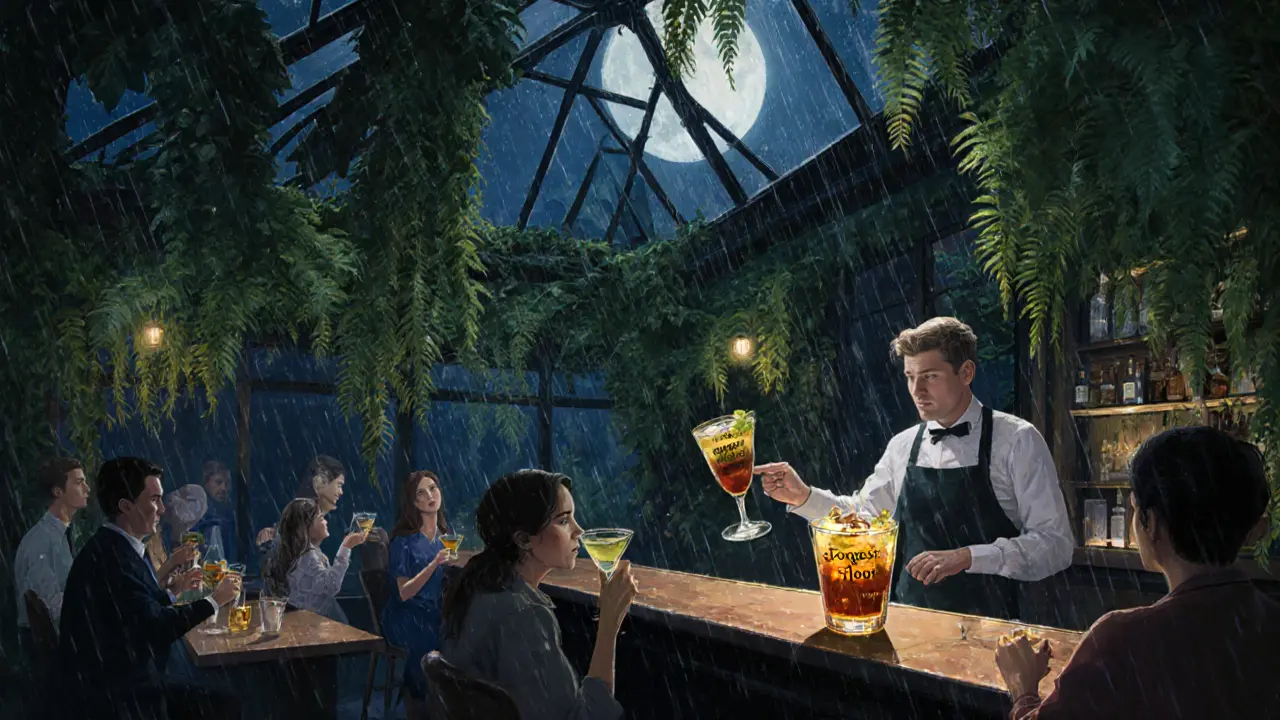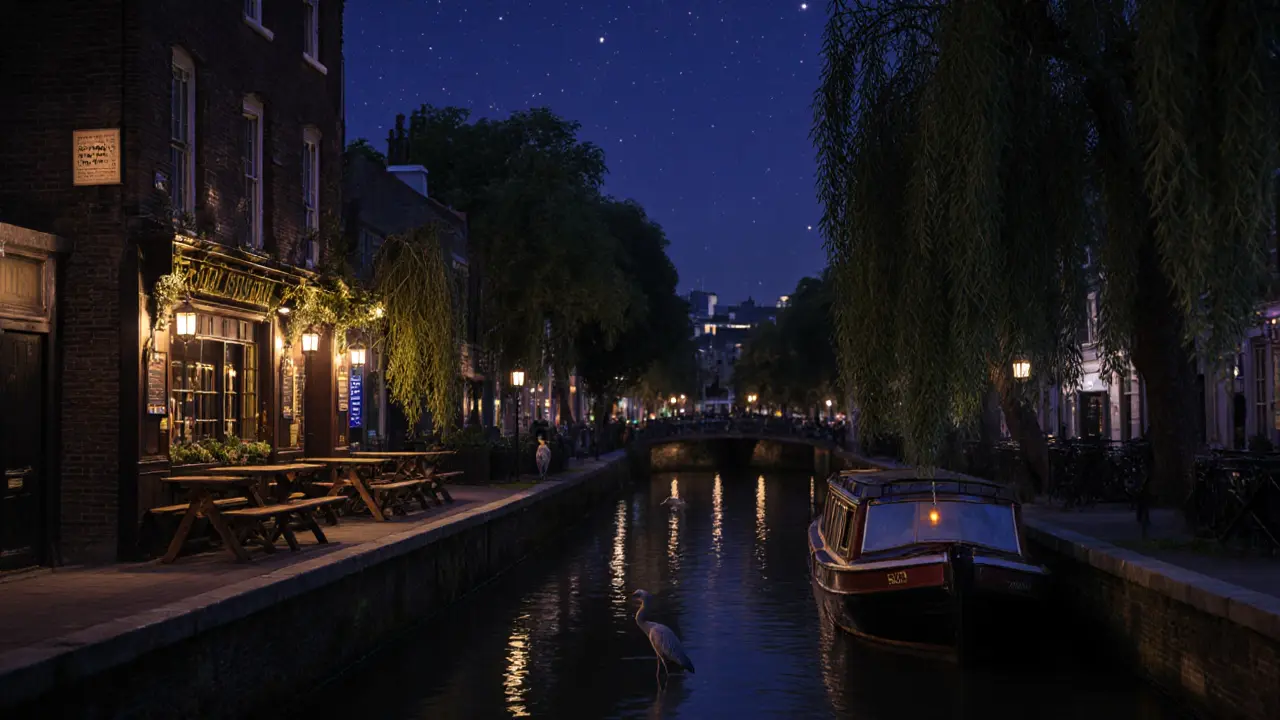The Best Nightlife in London for Nature Lovers
 Nov, 17 2025
Nov, 17 2025
London’s nightlife doesn’t have to mean loud clubs and neon lights
If you love quiet walks under streetlights, the sound of rustling leaves, or watching bats flit over water at dusk, you’re not alone. London has a quiet but growing scene of nightlife spots that blend urban energy with natural calm. You don’t need to leave the city to find peace after dark. In fact, some of the most memorable evenings happen when the city slows down and nature creeps back in.
Where to find nature in London after sunset
Most people think of London as concrete and noise. But over 47% of the city is green space - parks, rivers, canals, and woodlands. That’s more than New York, Paris, or Tokyo. And many of these spaces stay open late, or have bars and cafes tucked right into them.
Take Regent’s Park. By 8 p.m., the crowds thin out. The lights along the lake turn warm gold, and the trees cast long shadows. The Queen Mary’s Gardens have night-blooming flowers like evening primrose and moonflower that open just as the sun sets. There’s a small, low-lit bar called The Boathouse right on the water’s edge. You can sip a gin and tonic while listening to frogs croak and ducks paddle past. No music. No crowds. Just the hush of the night.
Down by the Thames, City Garden in Bankside is tucked between office buildings and the Tate Modern. It’s open until midnight, with string lights overhead and benches surrounded by lavender and rosemary. Locals bring books, not phones. The air smells like herbs and river mist. It’s not a party spot - it’s a place to breathe.
Bars that feel like forests
Some places don’t just sit near nature - they bring it inside. The Garden of Earthly Delights in Shoreditch is one of them. This bar has living walls covered in ferns and ivy, a ceiling of hanging vines, and a rooftop terrace where you can sit under a canopy of fairy lights and real trees. The drinks are named after plants: Thyme & Tonic, Nettle Sour, Willow Smoke. The bartender knows which herbs are edible and will explain how they’re used. No loud bass. Just jazz, softly played.
Another favorite is The Botanist in Notting Hill. It’s built inside a restored Victorian greenhouse. Glass panels stretch overhead, letting in moonlight. Rain falls on the roof, and the sound echoes gently. The bar uses only seasonal, foraged ingredients. Their signature drink? Forest Floor - a mix of elderflower, wild mushroom tincture, and oak-aged gin. It tastes like damp earth after rain.

Canal-side nights and hidden waterways
London’s canals are some of the city’s best-kept secrets after dark. The Regent’s Canal runs from Little Venice to Hackney, and along its banks, you’ll find quiet pubs with outdoor seating right over the water. The Narrow in Camden is one. It’s a narrow, candlelit pub with a tiny garden that spills onto the canal. You can sit on a wooden bench, watch the narrowboats drift by with their soft glow, and hear the water lap against the stone. No TVs. No jukebox. Just the occasional call of a night heron.
At The Horseshoe in Little Venice, you can order a warm spiced cider and sit on the bench outside as swans glide past. The owner keeps a list of the birds you’re likely to see at night - kingfishers, owls, even bats. She’ll point them out if you ask. It’s not a tourist trap. It’s a local ritual.
Guided night walks for the curious
If you want to explore nature after dark with someone who knows the hidden spots, book a Nature After Dark walk. These aren’t ghost tours. They’re led by ecologists and urban naturalists who show you how to spot owls in tree hollows, listen to the calls of nightingales in Hampstead Heath, or find glow-worms in the undergrowth of Richmond Park.
One popular route starts at Clapham Common at 8:30 p.m. and ends at a hidden pond where fireflies appear in summer. You’ll learn how to identify bats by their flight patterns, hear the difference between a tawny owl and a barn owl, and see how streetlights affect moth populations. The walks are limited to 10 people. You bring a flashlight. They bring the knowledge.
Why this matters - and how to do it right
Urban nightlife doesn’t have to mean noise pollution and wasted energy. These spaces show that cities can be alive with nature, not just with people. The best spots use solar lights, compostable cups, and native plants. They don’t blast music. They don’t flood the area with tourists. They respect the quiet.
If you want to enjoy this side of London, here’s how:
- Go on weekdays - weekends are busier, even at quiet spots.
- Wear layers - temperatures drop fast near water and trees after dark.
- Bring a reusable bottle - most of these places refill for free.
- Turn off your phone’s flashlight - use red-light mode if you need to see.
- Don’t feed the wildlife. Ever.
These places aren’t about being seen. They’re about being present.

Seasonal changes - what to expect through the year
London’s nature nightlife shifts with the seasons. In spring, the nightingales return to Richmond Park and the scent of lilacs fills the air. Summer brings long, warm nights - perfect for sitting under the stars at Waterlow Park with a bottle of sparkling cider.
Autumn is when the trees turn gold and the air gets crisp. Victoria Park hosts Full Moon Picnics - bring a blanket, a thermos, and a book. No alcohol? No problem. They serve herbal teas and hot chocolate.
Winter is quietest. But that’s when you’ll see the clearest skies. On clear nights, the London Planetarium in Regent’s Park opens its rooftop for free stargazing. You can lie on a blanket, look up, and see the Milky Way - something you can’t do in most cities anymore.
What to skip - and why
Not every bar with a plant on the table counts as nature-friendly. Avoid places that:
- Use fake plants and LED "green" lighting to look eco-friendly
- Play loud music even at 10 p.m.
- Have no outdoor seating or green space
- Charge £20 for a drink that’s just soda and gin
True nature nights are simple. They’re quiet. They’re local. They’re not trying to sell you an experience - they’re offering you a moment.
Final tip: Go alone once
It’s easy to think nightlife means company. But some of the most powerful moments happen when you’re alone. Sit on a bench by the canal. Watch the water. Listen. Let the city breathe around you. You’ll remember it longer than any club.
Can I bring my dog to these nature-friendly nightlife spots?
Most places welcome well-behaved dogs on leashes, especially along canals and in parks. But always check ahead - some indoor bars like The Botanist allow dogs on the terrace but not inside. Keep your dog quiet, clean up after them, and avoid bringing them to guided walks unless explicitly permitted.
Are these places open year-round?
Yes, most are open all year. Some outdoor seating areas close in winter, but the bars and cafes inside stay open. The Garden of Earthly Delights and The Botanist have heated terraces. Guided walks run from March to November, with winter stargazing events at the planetarium.
Do I need to book ahead?
For guided walks, yes - spots fill up fast. For bars like The Narrow or The Boathouse, no booking is needed, but arrive before 9 p.m. for the best seats. The Botanist takes reservations for groups of four or more. Walk-ins are welcome, but you might wait.
Are these spots family-friendly?
Many are. The Garden of Earthly Delights has a kids’ menu with herbal sodas. City Garden welcomes families until 10 p.m. Guided walks are for ages 12 and up, but private family tours can be arranged. Always ask if children are allowed on evening walks.
Is there public transport to these places?
Yes. Most are within a 10-minute walk from a tube or bus stop. Regent’s Park is served by Baker Street and Great Portland Street. The Botanist is a 5-minute walk from Notting Hill Gate. The Narrow is near Camden Town. Night buses run until 5 a.m. on major routes.
